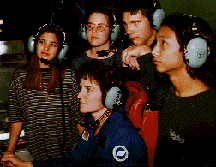Online Interactive Projects




The Internet is more than a library, a TV, or a printing press. One of its most exciting uses is as a tool of collaboration. It allows teachers and students around the world to work together to design inquiries and explore challenges. In addition to providing easy access to an incredible array of up-to-the-minute resources, it affords an easy way to meet and work with artists, scientists, writers, engineers and other professionals. For students, this helps to break down the artificial barriers between the school, the wider community, and the world of work. For teachers, it opens new paths to both professional development and school reform and restructuring.
Interactions between students and working professionals can be tricky to establish and maintain, however, and it may not be clear how to integrate them into an existing curriculum. That's why the NASA K-12 Internet Initiative has always made it a top priority to develop such programs and offer them "out of the box and ready to go" to classrooms around the world.
These projects--which we call "Sharing NASA"--allow to students to share in some of the excitment of authentic scientific and engineering pursuits like high-altitude astronomy, Antarctic biology, and robotics. These are full mutlimedia experiences, making use of television broadcasts and videotapes, printed workbooks, and online interaction over the Internet. Projects usually last from one to three months and are open to any teacher or student. In addition, we often use teachers, s tudents, and whole classrooms as volunteers on our projects, mainly helping with moderating the interactions between other students and our online experts.
Live from the Hubble Space Telescope in which three orbits of the best optical telescope available will be dedicated to student observations. The observations of Neptune (for two orbits) and Pluto (for one), with live television coverage, will be aired in March and April of 1996. An introductory television program is also available now.
Night of the Comet will track the exciting appearance of Comet Hyakatake which makes its closest approach to Earth on March 25, 1996. Opportunities will be provided to connect with NASA astronomy experts and to get the latest information and images about this recent discovery.
Online From Jupiter tracked the progress of the Galileo spacecraft as it encountered Jupiter in December of 1995. This project ran from November '95 to February' 96. Classrooms had an opportunity to connect with the men and women of the Galileo team. We hope to reactivate the project later in 1996 when a rich variety of science data is flowing earthward. To join this project, send an Email message to listmanager@quest.arc.nasa.gov. In the message body, write only these words: subscribe updates-jup
Live From the Stratosphere followed a team of airborne astronomers as they flew across the United States, conducting infrared astronomy research at 41,000 feet. The interactive parts of this project officially ended November 17, 1995. The project is part of the Passport to Knowledge series and included live television and a printed teacher's guides as well as online resources.
ShuttleMir Interactive will give teachers an opportunity to involve students in sharing the excitement of the Space Life Sciences participation in the U.S. and Russian space partnership, the Shuttle/Mir program. Activities will peak during the visits of U.S. astronauts, between September 1996 and June 1997.
Live From Mars will follow the Mars Pathfinder project. Current plans include a December 1996 spacecraft launch leading towards a Martian landing on July 4, 1997. Once arrived, the spacecraft will deploy a small rover to roam the Red Planet. An onsite (Washington DC) and online Teacher Workshop is tentatively planned for the July 19-21, 1996 timeframe; please stay tuned for more details.
Pathfinder: a lightweight, solar-powered, 8-propeller aircraft designed to cruise at 90,000 feet to monitor various earth systems. Originally this project was scheduled for Spring of 1996, but the aircraft was damaged by wind gusts and is presently undergoing extensive repairs
Live from Antarctica II: visit with the exciting researchers of Antarctica and learn about the science and extreme living conditions which make thier jobs a true adventure. This is project is a collaboration with the Passprt to Knowledge team which was responsible for the widely-acclaimed original Live from Antarctica (see below).
As we proceed, we'll make our findings known through a series of "Lessons Learned" papers. The first of these, covering the 1993-1994 Live from...Other Worlds pilot, is now available in HTML, in RTF (136k), or pre-formatted as a Common Ground document for Mac (282k) or Windows (322k).


This page was last updated on 3/2/1996.
The responsible NASA Official is Karen Traicoff.
Marc Siegel is responsible
for the contents of this page.